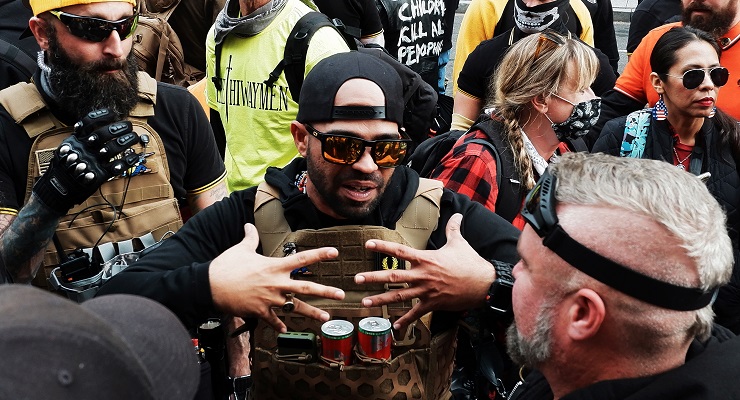How do journalists explain and interrogate the rise of the far right without amplifying and legitimising the views of its protagonists?
In just the last week, The Age reported on a group of neo-Nazis burning crosses in the Grampians, a Singaporean teen was arrested for allegedly planning a Christchurch-inspired terror attack, and Enrique Tarrio, leader of far-right gang the Proud Boys, appeared on the ABC.
The three incidents are a reminder of the fascist threat that will not go away. But they’re also chips in a larger debate rippling through the Australian media landscape: how do journalists explain and interrogate the rise of the far right without amplifying and legitimising the views of its protagonists?
Can Nazis ever be on TV?
In January, US journalist Molly Conger tweeted a (now viral) screenshot of a message from an overseas media outlet hoping to get an interview with people in the far right.
Conger’s response was to tell them to take a hike — such people should not be platformed on TV, she said. Within days, it was revealed the overseas media outlet was the ABC, who were sending star reporter Sarah Ferguson out to look at the final days of the Trump presidency.
Conger’s views — that people like the Proud Boys should almost never be put on screens because of the risk their dangerous views will be legitimised — is common on the left. And it’s also increasingly prevalent among a younger, more diverse group of journalists in the United States and Australia.
That’s put it in tension with a lot of traditional thinking in newsrooms, where journalistic conventions around questioning subjects, and the adage of sunlight as disinfectant, remain dominant.
Ferguson’s report, which aired on Four Corners on Monday night, wasn’t the first time she’s became a touchstone in that generational divide. In 2018, she interviewed former Trump adviser Steve Bannon, and in response to criticism, tweeted a provocatively chummy photo with him. Dismissed by senior journalists as “hysteria”, much of the criticism of the interview came from this different generation of journalists, many with lived experience of racial discrimination, who saw the interview as laundering Bannon’s views.




So should people like Bannon or Tarrio ever have a place on TV? La Trobe University’s Andre Oboler, founder of the Online Hate Prevention Institute, says usually not, and rubbishes the idea that such people are rational actors who can be easily owned by the gotcha question.
“The assumption that sunlight is the best disinfectant and people will learn from the debate is assuming that people are rational, and engage rationally, and I don’t think that’s true across society these days,” he says.
“By giving [extremist] views airtime in mainstream media, you’re giving them a sense of legitimacy, that this is a valid view for people to hold.”
This “handle with extreme care” approach is fleshed out in The Oxygen of Amplification, a 2018 report by Syracyse University’s Whitney Phillips which tries to provide best practice guidelines for newsrooms on reporting this stuff. According to the report, extremists are often highly strategic manipulators, “eager to use journalistic norms as a weapon against journalism”.
Ferguson v the Proud Boys
So, how has the Australian media fared recently on the ethics-in-Nazi-journalism front?
Kaz Ross, an independent researcher with expertise on the far right, said many extremism watchers tuned into Monday’s interview worried given Ferguson’s Bannon bit and Four Corners‘ desperately cumbersome attempts to find some fascists.
Ferguson asked Tarrio whether the Proud Boys planned to lynch members of Congress. Tarrio, shockingly, said no. No gotcha there.
“I didn’t see what the Proud Boys interview added to the story,” Ross told Crikey.
That said, Ross believes the report provided a good, compelling explainer of the carnage in Washington.
Other recent reporting shows how difficult it can be to walk the line between amplification and explanation. Oboler, for example, was critical of last week’s piece on the Grampians.
“There is a public interest in knowing what’s going on, but certainly naming the groups should be avoided, giving them the branding should be avoided from an ethics point of view,” he said.
The problem here is that journalists, academics, advocates and security agencies all have different stakes here. As journalists, our job is to report and explain. And according to Ross, Australia’s general lack of understanding of subtle, structural racism means people need the shock of slurs, Swastikas and burning crosses to make the connections for them. Such incentives can lead to reporting that in turn is criticised as sensationalist amplification.
Ross also worries there’s a narrative gaining traction on Twitter where any reporting on far-right figures that quotes them or explains symbols and behaviours is attacked for helping the far right.
“We can’t just pretend they’re not there, we need to know what they’re about, we need to know that if they’re left alone, they’ll fester.”
And on this point, Australia, unlike the US, doesn’t have many, if any, journalists working the far-right beat. While Nazis can’t be beaten by gotcha questions, they do need to be explained. We just might need to get better at doing it.




Fetch your first 12 weeks for $12
Here at Crikey, we saw a mighty surge in subscribers throughout 2020. Your support has been nothing short of amazing — we couldn’t have got through this year like no other without you, our readers.
If you haven’t joined us yet, fetch your first 12 weeks for $12 and start 2021 with the journalism you need to navigate whatever lies ahead.
Peter Fray
Editor-in-chief of Crikey








